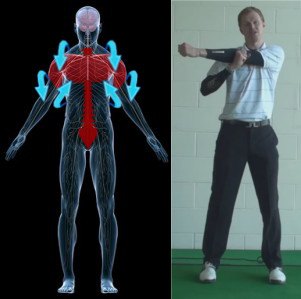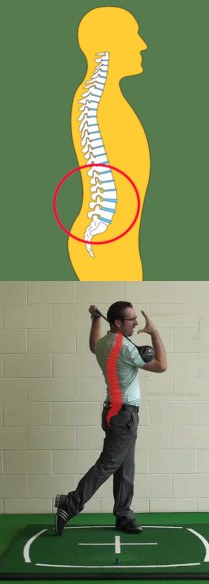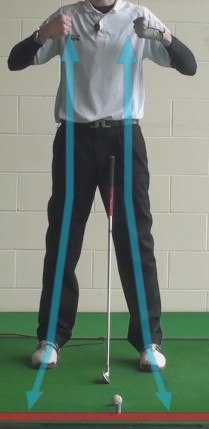
Injuries are rare in golf, but many avid players experience back problems due to the twisting action of the swing. Not only are back injuries painful, they can keep you off the golf course.
Here are some ways to keep your lower back strong and injury-free:
- Warm up with stretching and light swings. To stretch the torso, place a club across the shoulders, behind the neck, and rotate from side to side. Bending over to touch the toes will also help. Warming up is especially critical before early morning rounds.
- When placing the ball on a tee or retrieving it from the hole, bend at the knees, not the waist. You might also purchase an item made specifically for picking the ball from the hole, such as a small cup that fits onto the end of your putter.

- Alternate shoulders regularly when carrying your bag. This will keep your left and right sides in balance.
- Don't overpractice. Unless you're in excellent physical condition, pounding balls on the range will take a toll on your spine. Limit your practice sessions to no more than 60 full shots, and don't maintain your stance between balls.
If you love golf, you want to play as often as possible.

Also, you want to play the game for as long as possible, continuing to enjoy this pastime well into the future. Of course, if you are going to play frequently, and if you are going to play for a long time to come, you need to stay healthy. Golf is not a game which is associated with as many injuries as other, more physical sports, but that doesn't mean health is a given. Specifically, there are a few areas of the body that are known to commonly give golfers trouble. This article is going to focus on one such area – the lower back.
Chances are, if you play golf regularly and have friends who play as well, you will know at least one golfer in your circle who deals with lower back trouble. In fact, there is a good chance that you know several players in this position, yourself included. Because of the nature of the swinging motion, golf is hard on the lower back. If you do wind up with lower back trouble, the issue can range from mild to severe. In a good case, you may just feel some slight discomfort or tightness while you play, and your game may be compromised slightly. At the other end of the spectrum, serious lower back problems can make it impossible to play, the pain and physical limitations getting in your way of making a useful swing.
It needs to be stated right away that this article should not be construed as professional medical advice. If you are having back pain, the best course of action is to see your doctor to speak about the problem. This article is written only from a golf perspective, so it is focused on some ideas that may help you with back issues over the long run on the course. That is to say nothing about life away from the course. Always talk to your doctor before trying any new treatments and get professional medical attention for lower back pain.
All of the content below is based on a right-handed golfer. If you happen to play left-handed, please take a moment to reverse the directions as necessary.
The Inherent Problem

You don't need to be a back health expert to understand what it is about golf that causes it to be hard on your lower back. In fact, you don't even need to be a golfer to understand the problem. When you watch someone else swing a golf club, you can quickly see that there is stress being placed on the back. Specifically, the lower back bears a lot of the burden. The twisting motion that is required to hit a golf ball automatically causes plenty of stress to be put on your lower back, creating the risk of injury.
Unfortunately, it is actually the act of making a good golf swing which is going to put your lower back at risk. In a proper golf swing, the lower body remains relatively stable while the upper body turns away from the target. Having one half of your body turn while the other half remains stable is a great way to generate power, but it is also a good way to invite injury. If you were to make a poor swing with more movement in your lower body on the backswing, the burden might be reduced on your lower back. Of course, you also wouldn't be able to play the game at a very high level.
There really isn't any way to take the twisting out of the game of golf. If you are going to swing the club and do it in accordance with the rules of the game, you are going to have to rotate. This is simply part of the game, and if you decide to become a golfer, you should know that this risk exists. Not only are you going to be twisting your body, but you are going to be doing so while bent from the waist. This only increases the pressure placed on your lower back, and the likelihood that you will wind up with some kind of injury down the line. Unfortunately, once a golfer struggles with lower back problems, it seems that those problems just continue to come up time after time as the years go by.
So, at this point, it should be pretty clear that golf has the potential to lead to lower back problems. The twisting of the game is an awkward motion for your lower back to support, and injuries are possible as a result. But why would this lead to you getting hurt, when you probably rotate your body for other reasons from time to time during regular life? It all comes down to repetition. Golf is a repetitive game, asking the player to make similar swings over and over again from the first hole to the last. For most golfers, it is the accumulation of all these swings that leads to trouble. Repetitive stress injuries can happen as a result of performing almost any motion too often, whether it is swinging a golf club, typing on a keyboard, or anything else.
We would love to be able to offer a magic solution that could protect you from the possibility of lower back problems as a result of playing golf. Of course, that just isn't possible. Any recreational activity is going to expose you to the risk of some form of injury, so you have to weigh the pros and cons for yourself when deciding if you will participate. For most golfers, the risk of lower back problems is worth it when weighed against the great enjoyment they get from the game. That is a personal decision, however, so you'll need to make your own choice with regard to taking on this risk in order to enjoy what golf has to offer.
Using Common Sense

We have already established that golf can cause problems for your lower back health. With that said, there are some common-sense steps you can take to hopefully limit the damage that occurs as a result of playing this game. These tips aren't groundbreaking, certainly, but we hope they will at least help you think about a plan for your own needs.
Let's look at some of the ideas you may wish to keep in mind.
- Don't overdo it. All golfers love to get out on the links. If possible, some players would head to the first tee each and every day – and maybe multiple times per day. In most cases, golfers don't get out on the course that much because of other obligations in life. They need to go to work, take care of chores around home, etc. However, there is another benefit to moderating how much golf you play on a week to week basis. When you don't play a ton, you reduce the wear and tear on your back. One of the reasons so many professional golfers seem to come down with back trouble is surely the sheer amount that they play. If you can strike a nice balance between getting on the course enough to have fun and not so much that you wear out your body, you will do yourself a favor for the long run.
- Stay within your limits. If you try to force yourself to make the longest possible backswing on each and every shot, you are going to be straining your back even more than necessary. Instead, work on staying within your natural limits, making a backswing that is comfortable and doesn't require you to strain. That might mean not quite turning as far back as you were previously, but the benefit will be less pressure placed on your lower back. And don't worry – it's likely that you will lose very little, if any, distance at all. Most golfers think that it is necessary to make a huge backswing to hit long shots. That simply isn't the case. You do need a good turn, but it might not take as much as you think to send the ball rocketing down the fairway.
- Care for your back in cold weather. When the temperatures drop, it may be tougher to get your body warmed up and ready for action. Toward that end, make sure you are prepared when you golf on cold days. Get to the course a little earlier than usual so you can go through a proper warm up routine. Also, dress in layers and do your best to keep your body at a comfortable temperature. It will never be as easy to make a good turn in cold weather as it will be on a warm day, but you can improve your situation by making smart decisions.
- Don't play through pain. If you are experiencing pain in your lower back, stop playing and seek professional medical attention. The pain is a sign that something is not right in that area of your body and continuing to play through the pain only opens up the possibility for additional harm. No one likes to stop playing golf but think about it this way – you really aren't going to have much fun if you force yourself to play through the pain, and you aren't going to play well, either. With any luck, the cause of the pain will be something minor that doesn't keep you out of the game for long.
There is something about golf that causes people to make questionable decisions. For instance, swinging at 100% effort over and over again is not necessary to play good golf, yet plenty of golfers operate this way. Those players are not only harmed on the scorecard as a result of trying too hard, but they are also opening themselves up for physical harm. Swinging softer doesn't guarantee that you'll avoid back problems, but it should help to keep you safer. Also, golfers tend to take pride in playing through pain, even when doing so is not in their best interest.
A little common sense can go a long way toward keeping your lower back healthy. If you feel pain, stop playing and have the situation addressed by a medical professional. If you know you will be playing on a cold day, wear enough clothing to keep your body warm and comfortable. If you feel like you are always swinging your hardest, back off a little bit and focus on tempo rather than sheer effort. When you do the right thing on a day by day basis, you can look forward to better outcomes over the long haul.







